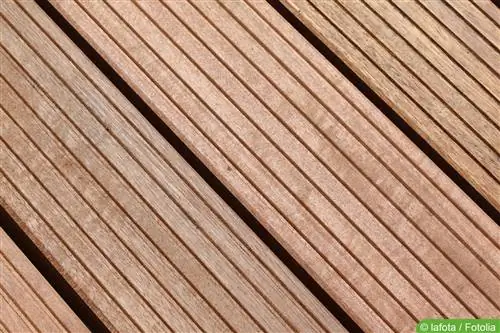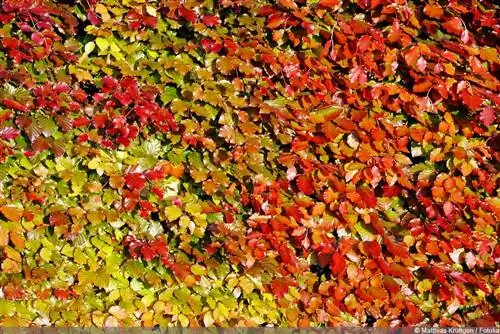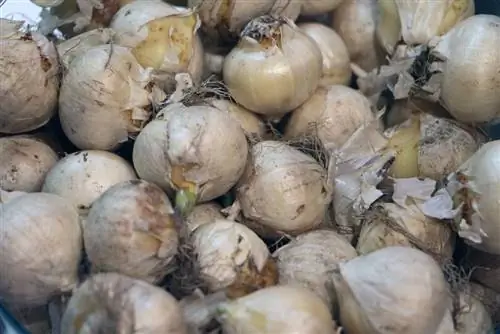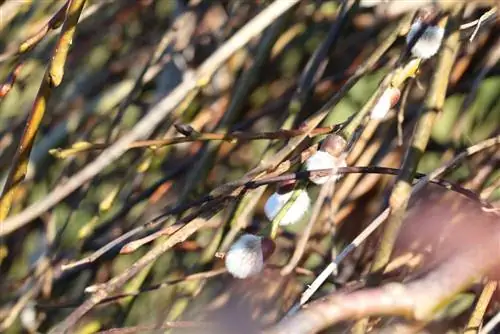- Author admin [email protected].
- Public 2023-12-17 03:39.
- Last modified 2025-01-24 12:45.
The potted plant enjoys particular popularity, which is not least due to its ability to bloom. However, the angel's trumpet requires optimal care, which also includes proper pruning. Only if this is carried out professionally at the optimal time and a few details are taken into account will the splendor of the flowers not suffer but will reward you with he althy growth and color intensity. Below you will find out everything you need to know and receive professional cutting instructions.
Time
Spring is the best time for pruning angel trumpets. Here the plant has left its winter quarters and awakened from its hibernation. In order not to expose them to frost, which increases the risk of frostbite many times over with fresh cuts, angel trumpets should never be cut before the Ice Saints and therefore only from mid-May at the earliest.
Pruning in autumn is also possible. Especially if the winter quarters only offer limited space, pruning during the months of October and early November makes sense as long as there is no frost in sight. Here, too, it is important that the pruning is done correctly, because in the worst case scenario the flowering could take a long time to appear the following year.
Cutting tool
An important factor is the correct handling of the cutting tool and the optimal selection. Angel trumpets have woody parts that should only be cut with appropriately sharp cutting tools. Special pruning shears are available from specialist retailers especially for thicker branches with woody areas. Knives are less suitable unless they are very sharp and have a smooth blade that allows you to cut wood and branches in one cut. However, this usually requires some practical experience.
Another point is the toxicity of trumpet flowers. After cutting, never leave your cutting tool within reach of children or pets. The latter could cause people to lick the cutting edges or knife blades due to the sweet flower juice and cause symptoms of poisoning.
Cutting hygiene
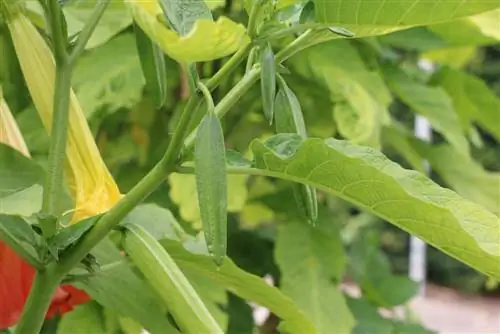
Especially due to the poisonous flowers of the angel's trumpet, it is extremely important that you always clean your cutting tool very well after use. The best way to do this is to disinfect it after thoroughly cleaning the scissors or knife with water and detergent.
The subsequent disinfection further deepens the degree of cleaning, removes any flower residues and also reliably removes any bacteria, viruses or other pathogens that could easily be transferred to other plants without additional disinfection if you treat them with the same cutting tool.
There are three different options available for disinfection:
Heating
You can disinfect the cutting sides of secateurs or a knife blade well in a flame. However, not every fire/flame is suitable for this because it has to be able to get hot enough. That's why you should limit yourself to a gas Bunsen burner or an alcohol flame. Hold the cutting device deep in the lower part of the flame for a few seconds, as this is where the highest temperatures prevail. Make sure that the cut surfaces in particular are heated well on both sides.
Isopropanol
Disinfection with isopropanol is another option. This is a special type of alcohol that, as a 70 percent solution, kills germs, viruses and bacteria. Isopropanol is available in pharmacies, drugstores and wherever medical supplies are sold. Alternatively, disinfection with pure spirit is also suitable. This should be mixed with distilled water in a ratio of 7:1. In both cases, immerse the cutting tool in the solution and leave it there for about two minutes. Make sure all parts are covered by the solution. To dry, place the cutting tool on a clean kitchen roll and let it air dry briefly. Then it is ready for use.
Chemical disinfection
You can also clean cutting tools with chemical disinfectants without any special preparation. For example, the specialist manufacturer of plant and garden supplies Neudorff offers the NeudoClean hygiene spray. This has the advantage that spraying is done quickly and the devices are disinfected after 60 seconds. A drying time or solution preparation is not necessary here.
Cutting technique
Basically, a Brugmansia, as the angel's trumpet is botanically called, should always be cut diagonally on the branch. This ensures a smaller cutting area and therefore also a wound area through which bacteria and other pathogens can get into the interior of the plant. Therefore, the general rule is: the smaller the cut, the lower the risk of illness.
In addition, a slanted interface ensures that water can drain completely, while water can stand on a straight wound. In the latter case, this would mean that the wound would need a longer time to dry and close again. This is also important to avoid the entry of pathogens. So: always cut diagonally!
Wound Care
If you want to be on the safe side, close the cuts in the form of a seal. This can be done using resin or wax, which are also available from specialist retailers as a finished product. This is particularly useful if the cut is made in late autumn, as high humidity can significantly delay healing and, in addition, the cold often causes the wound areas to begin to “bleed”. If you decide to seal only days after pruning, disinfection must be carried out beforehand. To do this, dust the cuts with coal dust or cinnamon flour.
Detect cutting area
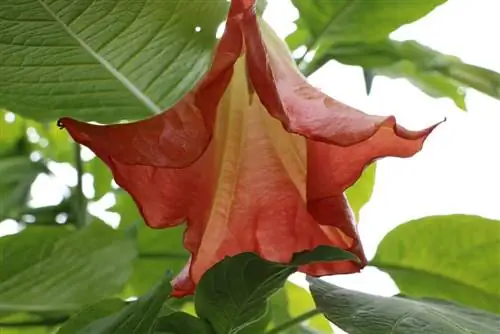
Before you just start cutting or following the cutting instructions for other plants, you should know that the Brugmansia has a special way of growing that distinguishes it greatly from other plants and must be taken into account when pruning for improved growth.
Flowering region
This container plant initially sticks straight up without branches. Here the shoot first lays itself out before it divides higher up for the first time. This division creates the so-called flowering area, which usually forms a bud on the first branch. Behind this, the second division usually occurs. From now on, flowers will flourish in this area during the flowering season between May and October.
Just cutting back the flowering area ensures improved growth of the Brugmansia and more flowers. The more numerous the divisions are, the more flowers you can enjoy. Only the flowering area is cut.
Leaf Types
For you, the special growth of the Brugmansia means that you can only cut off the upper area, which results from the first division. You can also identify the flowering area by the leaves. As a rule, the leaves in the flowering region grow asymmetrically. This means that one side of the leaf is set higher on the petiole than on the other side of the leaf. In contrast to this are the symmetrical leaves, in which both leaf sides attach to the petiole at the same height. These are almost exclusively found in the lower parts of the plants outside of the flowering region. Only occasionally can symmetrical leaves be seen in the flowering area.
Cutting
In the flowering area, Brugmansia is very robust and can also tolerate pruning that extends to the first branch. Pruning in this area promotes height growth as well as the growth of a dense foliage and buds or flowers. As a rule, there is no cutting in the lower area. New, just-growing shoots are also triggered by pruning in the flowering area. In this way, angel trumpets also increase in size. Although lateral shoots can be forced in the so-called growth zone, unfortunately this will not give you an increase in the number of flowers.
Autumn cut
Before the angel's trumpet moves to its winter quarters, pruning can make sense if there is not enough space.
Follow these instructions:
- Cut out only as much as is absolutely necessary
- Never cut deeper than 30 centimeters above the first branch division
- Do not cut in frost
- If necessary, place the plant in a warm place so that the cuts can dry out
- Alternatively, seal the interfaces
Intercut
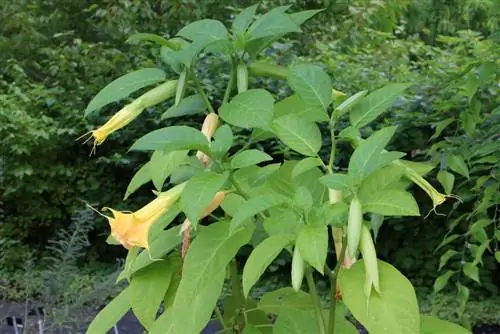
If your angel's trumpet's winter quarters are relatively warm and bright, it may happen that so-called winter shoots sprout during hibernation. Since these are usually very thin and weak, have little to no branches and the leaves are pale, they should be cut off as early as possible. They only take unnecessary energy and nutrients away from the angel's trumpet, which it needs in abundance in spring to form strong and he althy shoots.
Spring cut
When the cold gives way to warmer temperatures in spring and no more frost is expected after the Ice Saints at the latest, it is time for the spring pruning of the angel's trumpet. As with winter pruning, this should end at least 30 centimeters above the first fork above the growing area.
Tip:
You can use cut shoots as cuttings and grow new young plants yourself if you put the shoot tips in potting soil and keep them well moist. After about three weeks, roots have formed and the young plant can be potted.
Radical cut
A radical cut is always a high burden for every plant and especially for the angel's trumpet. But if a plant does not recover properly after an illness or pest attack, radical pruning is usually the last resort to keep the Brugmansia alive. It's definitely worth a try and the chances aren't that bad if you proceed as follows:
- Prune down to the growth area of the straight stems/trunks
- Prune only as deep as absolutely necessary (no deeper than 20 centimeters above the ground surface)
- Do not fertilize for at least the first six weeks afterwards
- Keep the plant warm and bright


